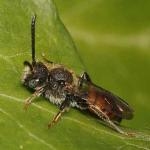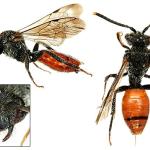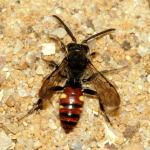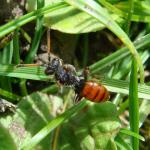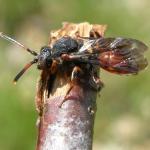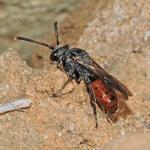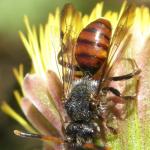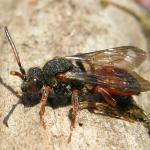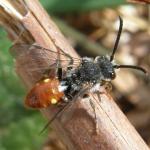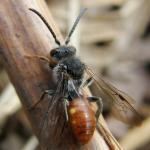Nomada germanica PANZER 1799; Nomada fabriciella KIRBY 1802; Nomada quadrinotata KIRBY 1802; Nomada nigricornis OLIVIER 1811; Nomada nigrita SCHENCK 1861; Nomada fabriciana var. aestivalis FRIESE 1921; Nomada fabriciana var. ruficrus E. STOECKHERT 1930
Females are easily identified by their reddish antennae with several of the intermediate segments being black. This banded appearance is visible in the field. It is also the only Nomada species which, in the British Isles, has (in both sexes) a combination of bidentate mandibles and a black labrum; the gaster is mainly reddish.
Widely distributed in England and Wales (especially so in the south), sporadic in Scotland and Ireland (possibly more widespread in Ireland than the few records suggest (Stelfox 1927)). It is known too from the Isle of Man and the Channel Islands. As might be expected, this range closely mirrors that of one of its common host species, Andrena bicolor (see maps). The species occurs throughout much of central and southern Europe, with records from as far south as Corsica and east to Turkey.
This species is not regarded as being scarce or threatened in Britain.
To be expected wherever its Andrena host species are well established.
Bivoltine, from March to June, and June to August. In Ireland, Stelfox (1927) did not detect a second brood.
Species include; Bogbean (Menyanthes trifoliata), dandelion (Taraxacum sp.), daisy (Bellis perennis), ragwort (Senecio jacobaea), field scabious (Knautia arvensis), speedwell (Veronica sp.), spurge (Euphorbia sp.), stitchwort (Stellaria sp.), strawberry (Fagaria vesca) and willow (Salix sp.).
None known.
2006
Updated: 22/12/2011


